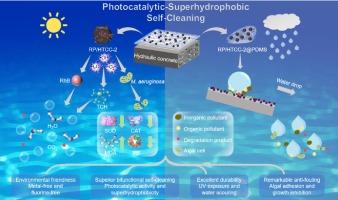IF 8.1
1区 工程技术
Q1 ENGINEERING, CHEMICAL
引用次数: 0
摘要
水工混凝土结构经常暴露在水环境中,极易受到无机固体颗粒、有机化学污染物和藻类等微生物的表面污染。为此,我们将具有光催化活性和超疏水性的红磷/热碳化碳(RP/HTCC)与聚二甲基硅氧烷(PDMS)相结合,开发出了一种新型无金属无氟涂层,可实现水工混凝土的卓越自清洁功能。HTCC 与 RP 的适当整合(RP/HTCC-2)带来了微纳米结构表面,改善了光吸收,优化了带能排列,增强了光生电荷分离和迁移。相应地,RP/HTCC-2@PDMS 涂层对混凝土表面的有机污染物降解具有良好的自清洁能力,在可见光照射 4 小时内,罗丹明 B(RhB)和盐酸四环素(TCH)在水中的降解率分别达到 97.6% 和 82.5%。同时,它还表现出显著的超疏水性,水接触角(WCA)高达 157 ± 0.5°,水滑动角(WSA)低至 6 ± 0.5°,从而实现了对粉尘的高效自清洁。此外,RP/HTCC-2@PDMS 对高强度的长期紫外线照射和水射流冲击具有很强的耐久性。此外,光催化活性和超疏水性的协同效应还进一步体现在涂层的藻类防污和抑制作用上。经过 12 小时可见光照射后,RP/HTCC-2@PDMS 涂层对水中铜绿微囊藻的抑制率达到 69.8%。对抑制机制的详细分析显示,超氧化物歧化酶(SOD)活性、过氧化氢酶(CAT)活性、丙二醛(MDA)含量、藻胶蛋白(PB)含量和藻类有机物(AOM)都发生了显著变化。总之,这些研究结果有望为绿色可持续自清洁涂层的开发及其高效、稳健自清洁的先进协同机制提供有价值的见解。本文章由计算机程序翻译,如有差异,请以英文原文为准。


A novel metal-free fluorine-free self-cleaning coating with photocatalytic activity and superhydrophobicity based on RP/HTCC@PDMS for hydraulic concrete
Hydraulic concrete structures, frequently exposed to water environments, are highly susceptible to surface contamination by inorganic solid particles, organic chemical pollutants, and microorganisms like algae. In response, a novel metal-free fluorine-free coating was developed by combining red phosphorus/hydrothermal carbonization carbon (RP/HTCC) and polydimethylsiloxane (PDMS) with photocatalytic activity and superhydrophobicity to enable superior self-cleaning for hydraulic concrete. The proper integration of HTCC into RP (RP/HTCC-2) introduced a micro-nanostructured surface, improved light absorption, optimized band energy alignment, and enhanced photogenerated charge separation and migration. Correspondingly, the RP/HTCC-2@PDMS coating exhibited good self-cleaning for organic pollutant degradation on concrete surfaces, achieving 97.6 % for Rhodamine B (RhB) and 82.5 % for tetracycline hydrochloride (TCH) in water within 4-h visible light irradiation. Meanwhile, it showed remarkable superhydrophobicity, with a high water contact angle (WCA) of 157 ± 0.5° and a low water sliding angle (WSA) of 6 ± 0.5°, driving efficient self-cleaning against powder dusts. Besides, RP/HTCC-2@PDMS demonstrated robust durability against high-intensity long-term UV exposure and water-jet impact. Furthermore, the synergistic effect of photocatalytic activity and superhydrophobicity were further evident in the coating’s algal antifouling and inhibition. After 12-h visible light irradiation, the RP/HTCC-2@PDMS coating achieved a 69.8 % reduction in Microcystis aeruginosa in water. Detailed analysis of the inhibition mechanism revealed significant changes in superoxide dismutase (SOD) activity, catalase (CAT) activity, malondialdehyde (MDA) content, phycobiliprotein (PB) content, and algae organic matters (AOM). Collectively, these findings are believed to provide valuable insights on the development of green sustainable self-cleaning coating and the advanced synergistic mechanisms driving their effective and robust self-cleaning.
求助全文
通过发布文献求助,成功后即可免费获取论文全文。
去求助
来源期刊

Separation and Purification Technology
工程技术-工程:化工
CiteScore
14.00
自引率
12.80%
发文量
2347
审稿时长
43 days
期刊介绍:
Separation and Purification Technology is a premier journal committed to sharing innovative methods for separation and purification in chemical and environmental engineering, encompassing both homogeneous solutions and heterogeneous mixtures. Our scope includes the separation and/or purification of liquids, vapors, and gases, as well as carbon capture and separation techniques. However, it's important to note that methods solely intended for analytical purposes are not within the scope of the journal. Additionally, disciplines such as soil science, polymer science, and metallurgy fall outside the purview of Separation and Purification Technology. Join us in advancing the field of separation and purification methods for sustainable solutions in chemical and environmental engineering.
 求助内容:
求助内容: 应助结果提醒方式:
应助结果提醒方式:


